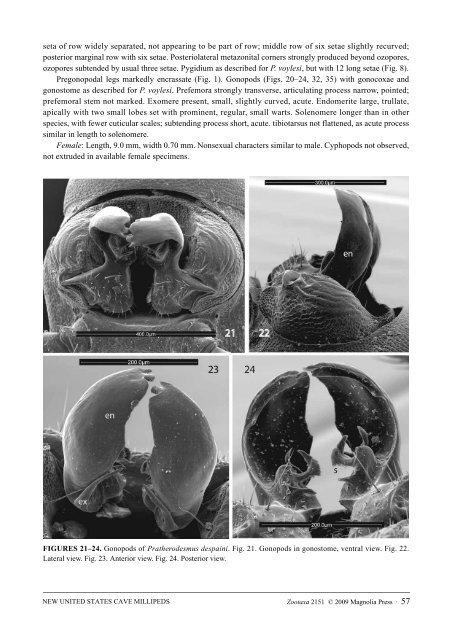Full article - Magnolia Press
Full article - Magnolia Press
Full article - Magnolia Press
Create successful ePaper yourself
Turn your PDF publications into a flip-book with our unique Google optimized e-Paper software.
seta of row widely separated, not appearing to be part of row; middle row of six setae slightly recurved;<br />
posterior marginal row with six setae. Posteriolateral metazonital corners strongly produced beyond ozopores,<br />
ozopores subtended by usual three setae. Pygidium as described for P. voylesi, but with 12 long setae (Fig. 8).<br />
Pregonopodal legs markedly encrassate (Fig. 1). Gonopods (Figs. 20–24, 32, 35) with gonocoxae and<br />
gonostome as described for P. voylesi. Prefemora strongly transverse, articulating process narrow, pointed;<br />
prefemoral stem not marked. Exomere present, small, slightly curved, acute. Endomerite large, trullate,<br />
apically with two small lobes set with prominent, regular, small warts. Solenomere longer than in other<br />
species, with fewer cuticular scales; subtending process short, acute. tibiotarsus not flattened, as acute process<br />
similar in length to solenomere.<br />
Female: Length, 9.0 mm, width 0.70 mm. Nonsexual characters similar to male. Cyphopods not observed,<br />
not extruded in available female specimens.<br />
FIGURES 21–24. Gonopods of Pratherodesmus despaini. Fig. 21. Gonopods in gonostome, ventral view. Fig. 22.<br />
Lateral view. Fig. 23. Anterior view. Fig. 24. Posterior view.<br />
NEW UNITED STATES CAVE MILLIPEDS<br />
Zootaxa 2151 © 2009 <strong>Magnolia</strong> <strong>Press</strong> · 57
















